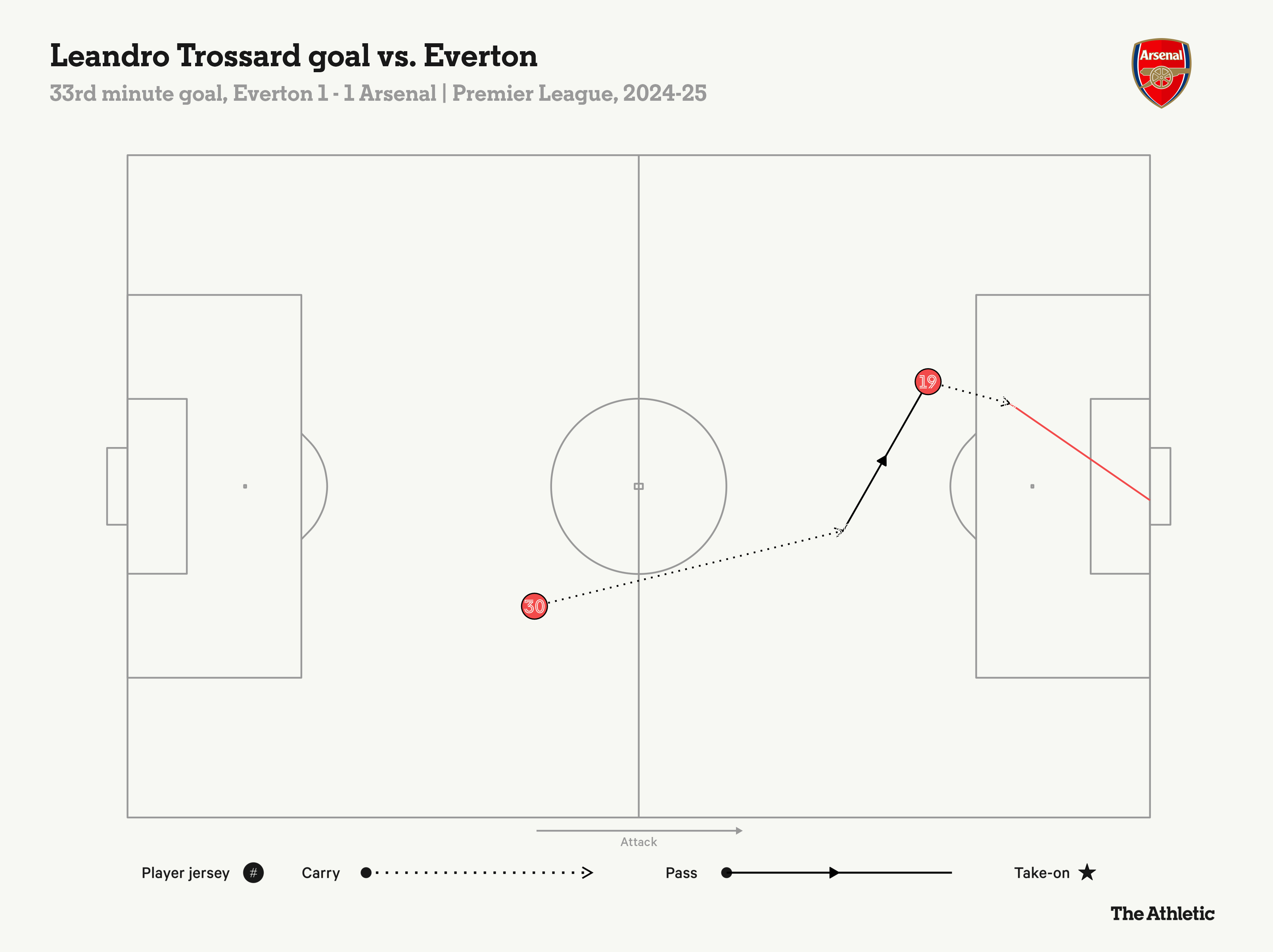
For a manager whose offensive principles are so focused around preventing opposition counter-attacks, the past 12 days ought to serve as a reminder to Mikel Arteta that his Arsenal side are capable of being devastating in transition themselves.
For the third Premier League game running — pun intended — Arsenal scored from a fast break on Saturday, which is a first in their five and a half years under Arteta. Opta defines these sequences as an attempt on goal created after the defending side attack quickly following a regain of possession inside their own half.
Leandro Trossard opened the scoring in the 1-1 away draw against Everton last weekend, after Arsenal cleared a cross and Idrissa Gueye’s midfield header dropped into Raheem Sterling’s path. He broke with Trossard in a two-v-two and, eight seconds later, the ball was in Jordan Pickford’s net.

On the previous matchday in midweek, Arsenal were mid-block defending at home against Fulham, 1-0 up midway through the second half, when the visitors’ centre-back Joachim Andersen tried an ambitious pass through midfield.
Declan Rice intercepted and passed forward to Gabriel Martinelli, one of four red shirts streaming forwards. He passed wide to Mikel Merino for what effectively became a one-two, as Martinelli then deftly flicked the Spaniard’s cross to the back post for Bukayo Saka to tap in.
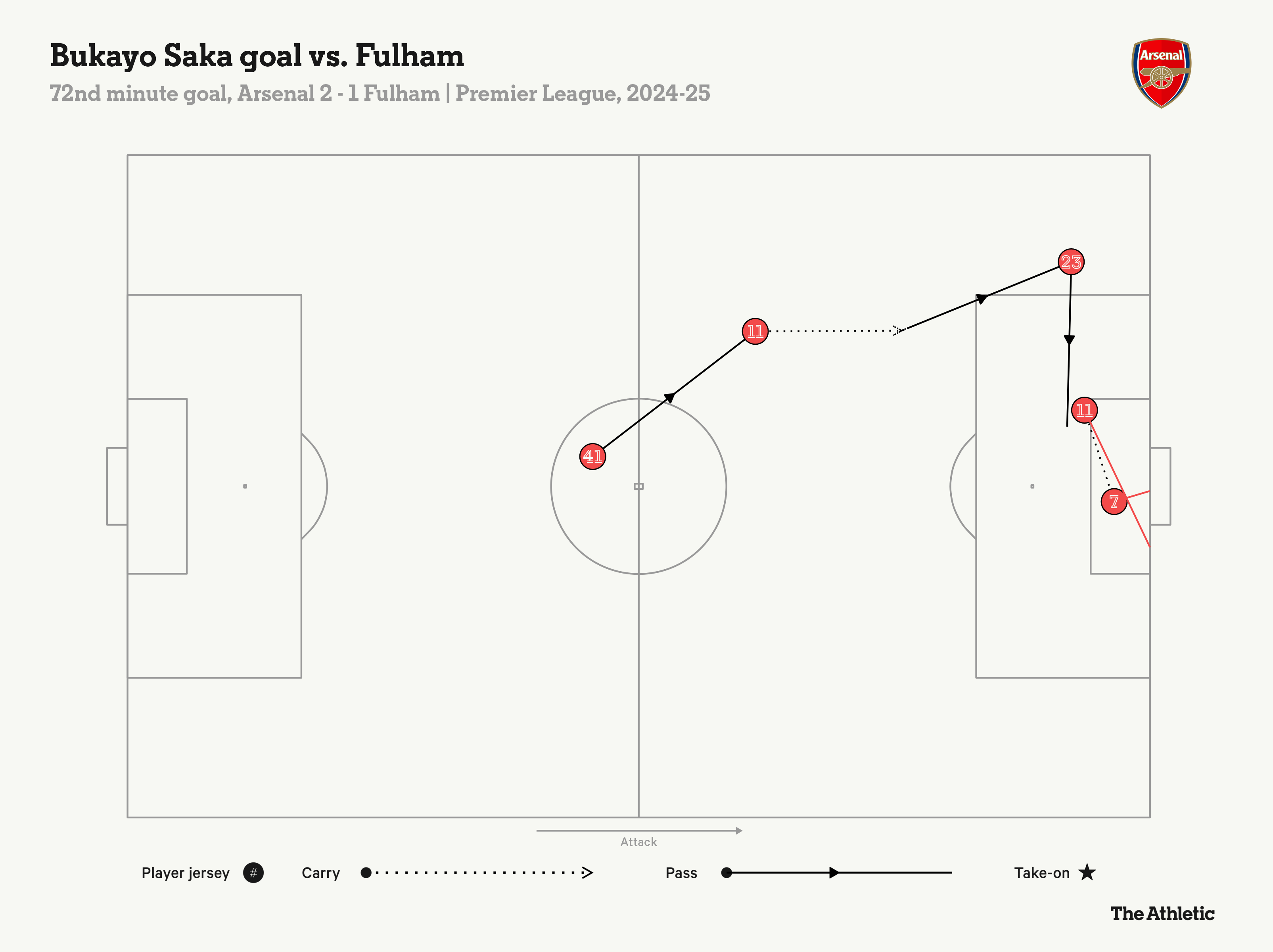
Those moves were both good.
Arsenal’s goal at home against Brentford yesterday was textbook counter-attacking.
As soon as David Raya caught Bryan Mbeumo’s inswinging corner, Rice snapped out of his defensive responsibilities and made a sprint upfield. He had made the same run four minutes earlier and Raya tried to find him, only for the move to break down. This time, the pass stuck, partly because Martinelli — deliberately positioned on the edge of the Arsenal box for these moments — had also started running and dragged Mikkel Damsgaard up the pitch with him, leaving Rice in space.
The overlapping Thomas Partey made it a three-v-two, and fired a shot past Mark Flekken from Rice’s pass. The England international had carried almost from box to box, so with just two passes, Arsenal had the ball in Brentford’s net, only 15 seconds after it was in their own penalty area.
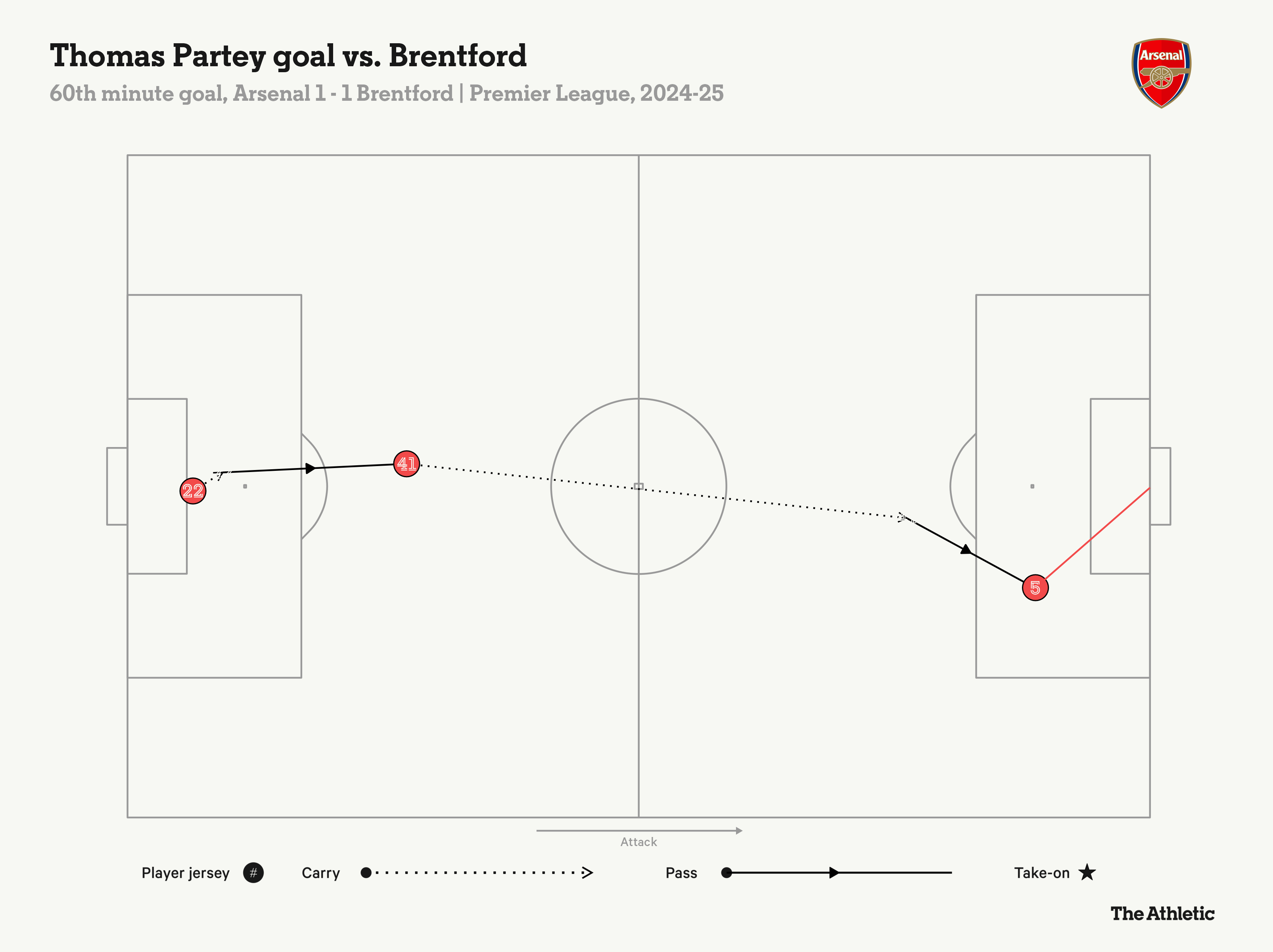
Arteta is often full of praise for opponents and their counter-attacking.
He spoke glowingly about Brentford in this regard pre-match, and also praised Chelsea’s ability in transitions last month.
Notably, when asked to compare Brentford to playing Real Madrid in the Champions League, with their two-leg quarter-final sandwiching Saturday’s London derby, the Arsenal manager said it would be a “completely different game (against) completely different opposition”.
Arsenal’s fast break goals, 2024-25
| Scorer | Opponent | Minute | Goal made it | Result |
|---|---|---|---|---|
|
Partey |
Brentford (H) |
60 |
1-0 |
1-1 draw |
|
Trossard |
Everton (A) |
34 |
0-1 |
1-1 draw |
|
Saka |
Fulham (H) |
73 |
2-0 |
2-1 win |
|
Merino |
Leicester (A) |
87 |
0-2 |
0-2 win |
|
Havertz |
Man City (H) |
76 |
4-1 |
5-1 win |
|
Trossard |
Tottenham (H) |
44 |
2-1 |
2-1 win |
|
Havertz |
West Ham (A) |
36 |
0-4 |
2-5 win |
|
Havertz |
Leicester (H) |
99 |
4-2 |
4-2 win |
|
Havertz |
Brighton (H) |
38 |
1-0 |
1-1 draw |
This was not just in terms of quality but match dynamics too.
Arteta understandably is more risk-averse in knockout European ties, but Premier League matches sometimes need to be forcibly opened up — even at the risk of fatigue or becoming defensively compromised.
Interestingly, Arsenal rank third for fast-break goals this season (they have nine, behind Liverpool with 13 and Tottenham Hotspur’s 10) but 10 teams in the division have had more shots from those situations than their 19.
It is one area where they have been particularly clinical under Arteta, scoring seven more than their expected goals (xG) figure from fast-break shots since the start of the 2020-21 campaign.
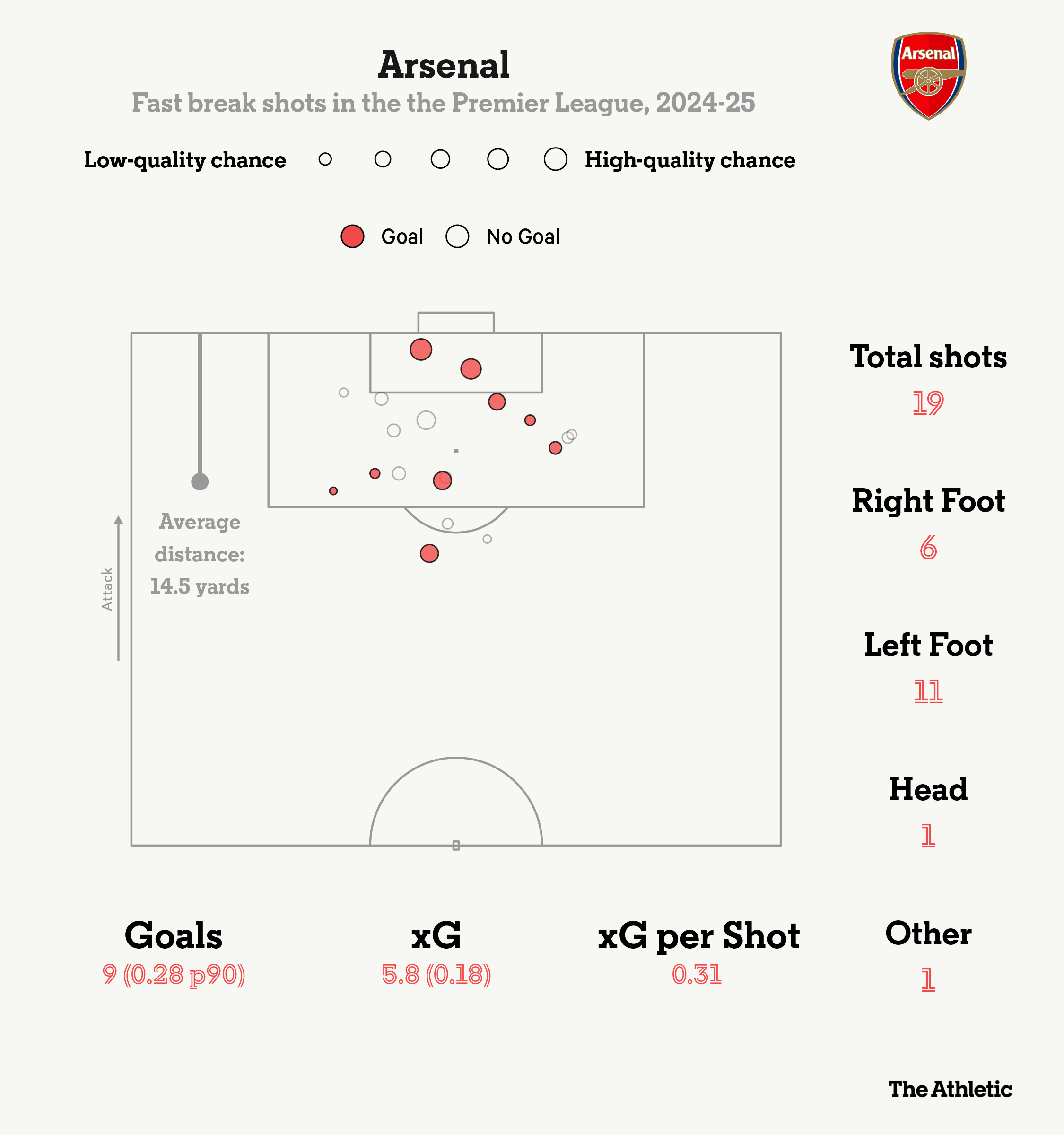
Brentford had a starting XI yesterday which was around 3cm taller on average than Arsenal’s, and stand-in No 9 Trossard struggled up against the physical presence of centre-backs Nathan Collins and Sepp van den Berg.
Because Trossard was isolated, when Raya sent long balls forward in an attempt to miss out the man-for-man press, Brentford had a two-v-one and could use one centre-back to block Trossard while the other won the duel.
Advertisement
Arsenal’s only other real moment of incisiveness came when Kieran Tierney headed in from the second phase at a corner, only to be ruled offside. Up against a team with a hybrid defensive approach — prepared to commit bodies upfield and press man-to-man, and, equally, defend in a low block — Arsenal’s routes to goal were limited and they found little joy aerially.
Brentford shut them down in transitional situations too. Christian Norgaard and Kevin Schade were booked six minutes apart in the first half for cynical challenges to stop Arsenal advancing with dribbles.
The Partey goal was Arsenal’s only big chance of the game, as they leaned into the big-distance ball-carrying strengths that Rice built his game on at previous club West Ham United.
Arteta said the opportunity for such moments, and counter-attacks more generally, “depends on the opposition behaviour. I think in the first half, we have a few options. When we break the press, when they’re just more man-orientated and they want to take more risks to open those spaces and sets and gaps, then a set piece is a clear situation because there’s a lot of space to run.”
Arsenal have made more of these “clear situations” this term, with nine goals from their 19 fast-break shots already the most they’ve managed in any season under Arteta.
Arsenal’s fast breaks since 2020-21
|
Season
|
Fast break shots
|
Fast break xG
|
Fast break goals
|
|---|---|---|---|
|
19 |
6.1 |
9 |
|
|
15 |
5.2 |
7 |
|
|
11 |
3.7 |
4 |
|
|
16 |
2.7 |
6 |
|
|
9 |
1.1 |
1 |
Notably, fast-break goals have been a recent trend for Arsenal. They only scored twice from fast breaks in the season’s first 20 Premier League games, and now have seven in the 12 since.
If there was an argument to be made that this was an approach they should lean into more with Kai Havertz out injured and less of a focal point up front, then recent matches show how essential this layer can be to their attacking style when the German forward returns — especially for a team with occasional open-play attacking limitations.
Advertisement
Counter-attacking is no longer simply a weapon for inferior teams but a natural byproduct of the athleticism that top teams recruit (often with an out-of-possession focus, particularly for Arsenal and their pressing intensity). There have already been more fast-break goals in the Premier League this season (99) than in all of the previous one (87).
So much of Arsenal’s success in the past two years has been their ability to prevent and defend opposition counters. For them to return to being genuine title contenders, they might need to evolve their own attacking transition threat.
(Top photo: John Walton/PA Images via Getty Images)
This news was originally published on this post .








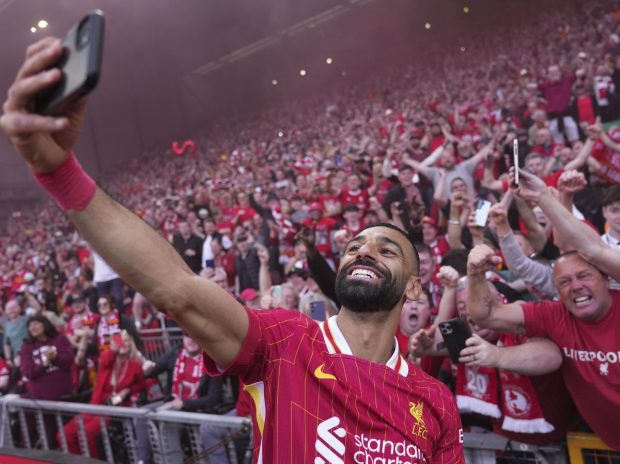



Be the first to leave a comment